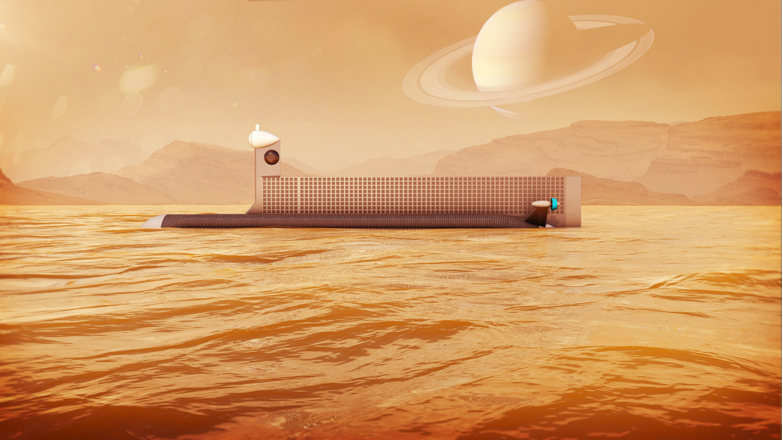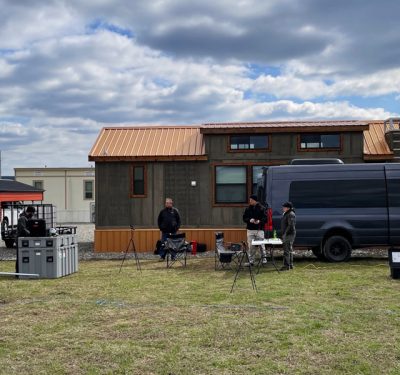
Titan Submarine.NASA
There is plenty for NASA scientists to explore on Titan, Saturn’s largest moon, including lakes and seas made of liquid hydrocarbons—making them much different from the lakes and seas we know on Earth. And while NASA can’t really send people to explore what’s below Titan’s methane seas, they can send an autonomous submarine.
That’s why NASA’s COMPASS Conceptual Spacecraft Design Team is working to design a submarine that would autonomously carry out detailed scientific investigations under the surface of Kraken Mare, Titan’s largest northern sea.
This would not only enable researchers to learn about an extraterrestrial sea, team lead and principal investigator Steve Oleson said, it would also mark NASA’s first foray into in situ nautical operations on other planets.
While this is an exciting project with many possibilities, it’s also in its very earliest stages. The COMPASS team was given $100,000 to come up with a conceptual design for the Titan submarine. That was Phase 1, and to be considered for the $500,000 Phase 2 funding, they’ll need to submit a proposal by the end of April. They recently outlined their design concept at the 2015 NASA Innovative Advanced Concepts 2015 symposium in Florida.
The team should find out if Phase 2 is a go by mid-summer, Oleson said, and if so, they will then shift their efforts to other areas, including how they’ll actually get the submarine to Titan, the only other body outside Earth with liquid lakes and seas on its surface. The second phase would also take recent information from Cassina, a NASA spacecraft that has been studying Titan since 2004, into consideration. In 2005, Cassini carried the Huygens probe to Titan, providing scientists with their first photos of this Earth-like moon.
While NASA has studied Saturn and its moons over the years, a submarine like the one proposed would enable them to take those studies much further, and to actually see what lies at the bottom of the sea in a different world. An autonomous submarine would give them the long range and maneuverability they need to study the Kraken Mare, and would work very much like an AUV on deployed on Earth.
Why Titan
Like Earth, Titan’s atmosphere is mostly nitrogen, and also contains small amounts of methane and other complex hydrocarbons. There is no magnetic field and its surface temperature is minus 290 Fahrenheit (minus 179 degrees Celsius), making water as hard as rocks and allowing methane to be found in its liquid form.
“This sea has some mysterious things going on, and we’d like to see what those things are,” said Oleson, who is based out of NASA’s Glenn Research Center. “But there are some big engineering challenges we have to overcome. It’s a sea of liquid methane and there’s no magnetic field on the planet. We have to figure out how to communicate with the submarine, how we get it to endure the harsh temperatures and determine what kind of balance systems we need to use.”
How it Would Work
The concept the team created would be deployed both on and below the surface of the Kraken Mare for 90 days, Oleson said. Seasons on Titan last for seven years, and for the best light the Titan submarine should be deployed during the summer months, which will begin in 2047. It will take five to seven years for the submarine to get to Titan, so that means the launch date would likely be in 2040.
When the submarine arrives on Titan, it will need to complete a water landing, and to then be able to communicate with Earth on its own, Oleson said. During a 90-day mission the 1,400 kg, 6 meters long Titan submarine would travel 2,000 kg. A cruise day will consist of eight hours submerged and 16 hours on the surface of the Kraken Mare.
“We want to do the science quickly because of the risk involved, but there’s no limit to the fuel at this point,” Oleson said. “We could run this for years.”
The submarine’s size and weight was determined by the science instruments it will need to carry to complete the mission, which will include various sensors, a light and camera system, a depth sounder, sample-acquisition gear, and side-scan sonar arrays.
The submarine’s antennas, located on each side, will make it possible for it to travel on the surface of the lake, while also maintaining communications back to earth.
What They’ll Study
The submarine will enable scientists to look at how rivers of methane flow into this moon’s seas and how the hydrocarbons work together with the ethane and methane rain. They’ll have the opportunity to measure chemical composition of the liquid, surface and subsurface currents, mixing and layering in the “water” column, tides, wind and waves, bathymetry, as well as bottom features and composition—measurements they’d never be able to complete without an autonomous submarine like the one Oleson and his team are proposing.
Not only that, this mission will help researchers understand the history and evolution of organic compounds in the solar system, making it “a critical step along the path to understanding the evolution of life here on Earth and potential life elsewhere in the galaxy,” Oleson wrote in a description of the possible exploration that appeared on NASA’s website.
“This will show us how all the particulates work together,” Oleson said. “There’s speculation life can form at boundary layers of liquid and sediments, so it could be a place where early life could have started. Not our kind of life, but life.”
The Team
Oleson and his team work on between 12 and 16 projects like this a year, Oleson said, and have completed 130 designs since 2006. They work together to brainstorm ideas and design various space crafts in about two weeks, he said, and determine what they will need to weigh, what size they should be to successfully complete the proposed mission and what they will cost to build.
This is their first maritime system, and Oleson said he hopes the team has done enough to get them to Phase 2, which will last two-years, and eventually Phase 3, where the concept will go from an extremely innovative, somewhat high-risk idea to something that’s closer to a reality.
Scientists Ralph Lorenz of John Hopkins University Applied Physics Laboratory and Dr. Michael Paul of Penn State University’s Applied Research Laboratory, along with the COMPASS team, have been instrumental in completing this initial design Oleson said, a design they hope will someday carry out their visions of exploration beneath Titan’s Kraken Mare sea.






